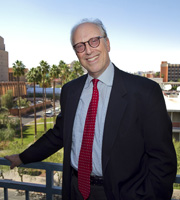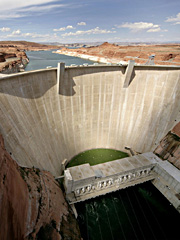
|
|
May 27, 2011
Dear Board Member,
|
| |
|
Below, for your planning purposes, is a schedule for the next three Board meetings through 2012. We look forward to your participation. If you have any questions, please contact Laura Boyd or Patricia Reiter.
|
| |
|
Following the schedule is our brief listing of recent ASU sustainability news and activities. Afterward, we present Dr. Michael Hanemann, ASU’s newest member of the National Academy of Sciences. Professor Hanemann is an environmental economist specializing in adaptive management for climate change.
|
| |
|
Schedule for Board of Trustees Meetings |
| |
|
Fall 2011
Location: Tempe, Arizona
|
| |
|
Tuesday, September 27, 2011
|
|
Wednesday, September 28, 2011
|
| |
|
Spring 2012
Location: Tempe, Arizona – In conjunction with the International Conference on
Sustainability Science (ICSS)
|
| |
|
Monday, February 20, 2012
10:00 a.m. - 2:00 p.m. – Board Strategy and Business Meeting with Lunch 2:00 - 5:00 p.m. – Board members attend roundtable with conference speakers Evening – Board members attend ICSS Conference Reception
|
| |
|
Tuesday, February 21, 2012
|
| |
|
Fall 2012
Location: Tempe, Arizona
|
| |
|
Tuesday, September 18, 2012
|
| |
|
Wednesday, September 19, 2012
|
 |
|
Highlights of ASU sustainability activities
|
| |
- The School of Sustainability celebrated its third spring convocation on May 12 by honoring 113 graduates of the class of 2011. This more than doubled the School’s alumni population, which now stands at 221. New graduates included 2 doctoral students, 10 master’s students, and 101 undergraduates.
Read more »
|
| |
- The ASU-led Power Systems Energy Research Center (PSERC) received a $5.5 million grant from the U.S. Department of Energy to develop new strategies for integrating sustainable energy into a smarter electrical grid. Senior Sustainability Scientist Vijay Vittal, a professor in the Ira A. Fulton Schools of Engineering, directs the program, which is funded by the National Science Foundation as an Industry/University Cooperative Research Center. The center includes 13 universities and 36 industry partners across the U.S. and in Canada.
Read More » | About PSERC »
|
| |
- ASU is expanding its work with Intel and the United States Agency for International Development to improve higher education and technological development in Vietnam through the Higher Engineering Education Alliance Program. Originally launched in 2010, the program has received an additional $2 million to expand its reach, particularly to modernize vocational education and instructional technology at Vietnam’s top technical universities and attract more Vietnamese women to engineering.
Read more » | About HEEAP »
|
| |
- Biology and design students teamed up in ASU’s first biomimicry class this spring to apply the inspirations of nature toward solving sustainability challenges. The class was part of a series of biomimicry initiatives fostered by InnovationSpace, a transdisciplinary education and research lab for product innovation in ASU’s Design School. Class projects included reducing water consumption and mitigating urban heat island effect.
Read more »
|
| |
- Four ASU researchers from the Flexible Display Center and the Motivational Environments research group provided key hardware and functionality for the newly unveiled PaperPhone, a prototype billed as the world’s first interactive paper computer. Developed in conjunction with Queen’s University in Ontario, Canada, and E Ink Corporation, the new paper computer is thin, lightweight, flexible, stackable, and manipulated by bending gestures. Developers believe it could end reliance on paper and printers in offices.
Read more »
|
| |
- Ditch the Dumpster, a year-end move-out donation and recycling drive that engages students in achieving ASU’s sustainability goals, collected 32,888 pounds of reusable or recyclable goods in 2011, up from 9,975 pounds in its inaugural year, 2008. Collaborators on the university-wide project include University Housing, Global Institute of Sustainability, ASU’s Center for Student Sustainability Initiatives, Swift Charities for Children, and others. Ditch the Dumpster won the 2011 President’s Award for Sustainability.
Read more » | About DTD »
|
| |
- Intel and ASU have completed the first phase of a joint project called “Zero Emission Fabs” that harnesses carbon dioxide emissions to grow algae for biofuel on the roof of Intel’s Ocotillo manufacturing campus in Chandler. ASU’s Laboratory for Algae Research and Biotechnology built and monitors the rooftop bioreactors with funding from Intel's Sustainability in Action program. The Ocotillo campus is the first semiconductor manufacturing facility to earn Leadership in Energy and Environmental Design (LEED) silver certification.
Read more »
|
| |
|
Please feel free to email or call us with any questions or comments about this briefing.
Best regards,
|
| |
cc: Jim Buizer
|
| |
�
Q&A With Dr. Michael Hanemann
Assessing the cost of climate change
|
|
Michael Hanemann is a Distinguished Sustainability Scientist in the Global Institute of Sustainability and Julie A. Wrigley Sustainability Chair in the School of Sustainability and the Department of Economics, W. P. Carey School of Business. His research focuses on environmental economics and policy, water pricing and management, and the economics of adaptive management. In May 2011, he was elected to the National Academy of Sciences.
|
|
At what point did “sustainability” become part of your research vocabulary?
As an environmental economist, sustainability has always been part of my research. This goes back to my second year in graduate school, when I had a summer job writing a report for a federal agency on the effects of rapid urbanization on public water supply systems in Phoenix, Tucson, Miami, Seattle, and the outer Boston suburbs.
|
|
What are your most important sustainability-related research projects?
I am working with the California Energy Commission and local governments in the San Francisco Bay Area on two issues: to assess the vulnerability of Bay Area communities to climate change, and to develop appropriate adaptation strategies that focus on water, transportation, coastal impacts, agriculture, and health. While climate change may not be the biggest stressor right now compared to population growth and urban land use conversion, it might create a tipping point because of the increased variability and uncertainty that climate change introduces. In a similar vein, I am also working with Spanish colleagues on issues of adaptation to climate change in Spain.
Among my other projects, I am assessing the future water needs of the Hopi Tribe of northern Arizona under a new state standard that calls for an adequate supply of water to make the reservation a “comfortable homeland” and to permit sustained economic growth. I also have a continuing interest in the operation of Glen Canyon Dam and its impacts on the Colorado River ecosystem in Grand Canyon. I served on the original National Research Council committee investigating those impacts in the 1980s and I am now assisting the U.S. Geological Survey as it moves to implement an adaptive management strategy for the dam.
|
|
How will your sustainability-related research affect policy or other important decisions?
Over the course of my career, I have worked with policymakers at the state and national level to shape environmental and water policy in a manner that fairly balances the needs of current users with the interests of long-run environmental preservation and sustainability. With respect to the global issue of climate change, I am serving on Working Group III of the Intergovernmental Panel on Climate Change’s (IPCC) Fifth Assessment Report, which we hope will have a significant international influence when it emerges in 2014.
|
|
What is the world sustainability challenge that concerns you most?
Water supply and climate change are the two challenges that concern me most, both individually and jointly. While aquatic ecosystems are currently strained by population growth, economic development, and land use changes, the effects of climate keep building up – perhaps more quickly than many suppose.
|
|
|

Dr. Michael Hanemann
|

Climate change is expected to affect the San Francisco Bay Area’s communities, agriculture, and water supplies.
|

Adaptive management may mitigate some of Glen Canyon Dam’s profound impacts on the Colorado River ecosystem.
|
|
|







